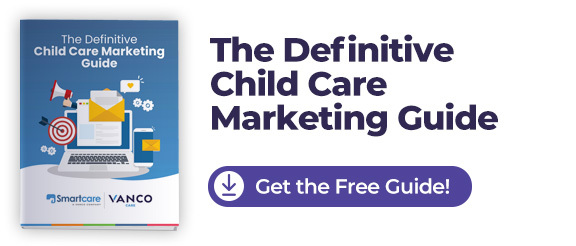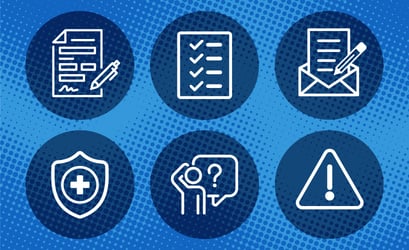Demand for high-quality, developmentally engaging early child care is growing. Parents of young children seek out exceptional child care, and the demand for preschool programs that support kindergarten readiness is increasing.
Your early child care center’s prestige can increase with a defined growth strategy. Create a solid program that connects your academic focus with that of local public or independent school readiness requirements. By focusing on both quality child care and academic kindergarten readiness, you can propel your reputation as your graduates enroll at public, private, or independent kindergarten programs.
Based on our experience with thousands of schools across the country, we’re seeing a renewed demand for developmentally engaging child care services and successful implementation of strategies to grow enrollment and quality.
Learn More about our Preschool Management Software.
How can you grow enrollment and quality in your child care program into a school growth strategy?
1. Start with the Data
Changing needs and expectations of young families show that they want developmentally engaging learning services. They are more often working parents who want a broader range of services that are individually and personally delivered.
The majority of U.S. children under five are students of color, so diversity and cultural awareness are even more critical in the training and recruitment of faculty, in the development of the curriculum, in communications to families, and out to the broader community.
The more educated parents are, the more likely they are to enroll their children in a child care center.
In 2016, the percentage of 3 to 5-year-olds enrolled in preschool was:
54% for those children whose parents had a graduate or professional degree
41% if the parents earned only a bachelor’s degree
37% for parents who ended their education with an associate’s degree
37% for those with some college but no degree
33% if they stopped with a high school credential (33%),
30% if parents didn’t complete high school
Public demand for early childhood education is accelerating. Philanthropists, community leaders and policy makers are seeking “opportunities to build new capacity in the early learning field as it enters a critical next stage.” For example, in 2018 Jeff Bezos announced a $2 billion plan to fund full scholarships for low-income children to attend “Montessori-inspired” preschools. The Saul Zaentz Early Education Initiative at Harvard University is another example.
As students transition from child care to the education system, it’s important for them to have skills in learning behaviors, such as their ability to:
- Pay attention in class
- Follow classroom rules
- Complete tasks independently
- Show eagerness to learn
At kindergarten entry, students who perform well in learning behaviors have a positive correlation to test scores.
When students enter kindergarten, many of them are not equipped with the skills to support learning success:
- A national survey of kindergarten teachers reported that 35% of their students were not ready to “participate successfully in school”.
- Problems that affected readiness included deficiencies in language, emotional maturity, general knowledge, social confidence, moral awareness, and physical well being.
Fact: Demand for High Quality, Developmentally Engaging Early Child Care Services is Growing
2. Develop Strategic Growth Plans for Child Care Centers and Preschools
Both independent child care programs and private school pre-K to grade 8 programs will benefit by having a strategic growth plan.
For independent child care programs where students move to public or private schools:
Understand that your center needs goals and plans for growing and sustaining. Your center plays an important part in your community. Your families are relying on you to be aware of local school academic and behavior readiness. Building community relations with local schools should be an important part of your growth plan. Network with local educators and school principals to share news about your center, ask for their input on your program, and work together to build a strong bridge to kindergarten.
For private and faith-based pre-K through Grade 8 schools:
With an integrated marketing and enrollment management strategy, your preschool program can provide a strong base of students for your kindergarten and elementary grades. Certainly not every student will be expected to stay beyond preschool, with a national average of 40-60% reenrolled/retained into kindergarten, but these classes should provide a reliable base for elementary grades.
With some preschool families you will have to Bless and Release them, assuring them of your support for their next decision and your genuine appreciation for the positive contributions they have made in preschool. They may have already pre-determined their plan to attend another school, but you can still cultivate them as brand ambassadors for your school out in the community.
After leaving your school, some may eventually Return to Sender, where they come back to your school after becoming disillusioned with their other choice and remembering the quality of the relationships and education provided at your school. Because families today are increasingly opting for private education in the middle school and high school years, your child care services should be viewed as a long-term investment to build your brand and grow the upper grades.
Fact: It’s important to establish a strategic growth plan to build intentional relationships
Retaining families in your child care program begins with intentionally cultivating deep relationships with each one. This requires a commitment from the center’s leadership and every employee to sustain a culture that values genuine interest in people, active listening, and responding appropriately to sustain trust and engagement.
3. Work with Neighboring Schools
Community relationships
In A Unified Foundation to Support a Highly Qualified Early Childhood Workforce, experts in education came together to discuss the importance of aligning early child care programs with larger education efforts to build a unified foundation for children, noting:
“To provide guidance and support for efforts at the local, state, and national levels, national nongovernmental organizations that offer resources and support for the care and education workforce should collaborate to provide and periodically update shared, coherent foundational guidance for care and education professionals working with children from birth through age 8. This collaborative effort should represent professional roles across settings and age ranges to improve the consistency and continuity of high-quality developmental support and learning experiences for children as they age.” (p. 545)
Academic and behavioral expectations
Working with the larger K-12 community allows child care centers to better prepare their students for the next step in their education. In many states, children are not school ready when they enter kindergarten. In fact, in Mississippi, kindergarten teachers report the lack of school readiness as their top challenge.
Positive networking can increase awareness of your school
Positive experiences for families in early child care centers and in K-12 educational programs can result in a buzz around the community for both. By communicating a dynamic partnership to the community as a whole, there are more opportunities for parents to hear about your school or child care center.
Children benefit from great foundational expectations
School and community partnerships can result in a seamless transition for students moving from a child care center to elementary school. Research confirms quality early child care set students up for a lifetime of academic success.
Parents benefit when educators are informed and working in tandem
When child care centers and schools work together, they are able to develop community programs that can help parents develop social networks and better understand the education system.
Question: How does your state stack up?
Check out the state-by-state map, at ceelo.org/state-map, developed by The Center on Enhancing Early Learning Outcomes, to learn more about early learning guidelines for early child care, along with documents for teachers and families to better understand the standards.
If you’re looking for examples of ways child care centers and schools partner together, the Institute of Education Sciences has a wealth of resources!
4. Propel Your Growth Strategy
Build Your Team
Faculty quality and engagement is the leading predictor of student growth and school growth. Don’t compromise when it comes to building a talented team of gifted educators and then nurturing a culture in which they can thrive.
Talent is a discipline that starts at the top and must assure alignment with the mission, culture, strategies, and expectations—in that order. Build a team of talented, energized, engaged educators and you will grow.
Craft Your Story
Your brand narrative is critical as you seek to establish your child care center as a launching point for success for young students. Craft your story as an invitation to join together in the journey of raising each child. Cast the parent as the hero of the narrative rather than repeating a similar list of features that can be heard at other schools in the area. Train every employee in how to tell your story consistently and effectively.
Share Your Story
There’s no advantage for your child care center to be the best kept secret in town. Equip your faculty and families to be ambassadors for the school, telling a consistent and compelling story.
Use Your Data
You have a wealth of data in your student information system. Use your data to learn, improve, and grow.
Craft an Engaging Value Proposition
Distinguish your child care center with a plan that maximizes your unique organizational genius and delivers remarkable value.
Conclusion
There’s never been a more important time to establish a growth strategy.
Since 1985, the cost of child care has nearly doubled, even when adjusted for inflation. As a matter of fact, child care is the costliest annual expense for most families.
You have the privilege of partnering with families as they seek to raise children who can enjoy their childhood while also effectively preparing them for their educational future. Parents want gifted teachers who will genuinely love their child, friends who will be a positive influence and share their values, curriculum that includes social/emotional learning to help their child build healthy relationships with peers, and the opportunity for their child to learn through play.
Families are looking for a child care center that will help their children manage their behavior and emotions to be learners, deal with their emotions, and pay attention in an educational environment. These are ideals and values both child care centers and the larger K-12 education community can help bring to fruition through a strong growth strategy and partnership.
Research Resources
Adams, D., L. A. Bornfreund, J. E. Carinci, L. Connors-Tadros, L. Fraga, A. Guarino, W. Hao, B. Hudson, R. M. Kor, S. LeMoine, J. Lockwood-Shabat, J. Martella, D. S. Mathias, C. McLean, C. Polk, P.S. Rogers, T. Rucker, S. D. Russell, A. A. Samuel, C. Stevens, T. N. Talan, V. Washington, and V. Williams. (2017). A Unified Foundation to Support a Highly Qualified Early Childhood Workforce. NAM Perspectives. Discussion Paper, National Academy of Medicine, Washington, DC. doi: 10.31478/201706b
Center on Enhancing Early Learning Outcomes. (n.d.). State-By-State. [online] Available at: http://ceelo.org/state-map/
Franks, E. (2019). A Leadership Shift. [online] NAESP. Available at: https://www.naesp.org/blog/leadership-shift
Harris, L. (2019). School readiness for children in the United States. [online] Uptodate.com. Available at: https://www.uptodate.com/contents/school-readiness-for-children-in-the-united-states
Nces.ed.gov. (n.d.). Fast Facts: Knowledge and skills at kindergarten. [online] Available at: https://nces.ed.gov/fastfacts/display.asp?id=680
Nces.ed.gov. (2019) Preschool and Kindergarten Enrollment. [online] Available at: https://nces.ed.gov/programs/coe/indicator_cfa.asp
Riddell, R., Jacobson, L. and Campisi, J. (2019). 6 K-12 trends to watch in 2019. [online] Education Dive. Available at: https://www.educationdive.com/news/6-k-12-trends-to-watch-in-2019/543915/
Sonenshein, J. (2015). 8 facts about childcare that will make you think twice about whether you can afford to have children. [online] Business Insider.
Squires, J. (2015). SCHOOL-COMMUNITY PARTNERSHIPS FOR EARLY LEARNING SUCCESS. [online] Ceelo.org. Available at: http://ceelo.org/wp-content/uploads/2015/07/ceelo_presentations_squires_ms_ec_conf_school_community_partner_2015_07.pdf









